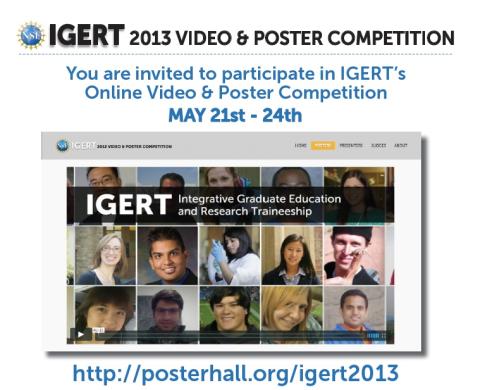event
2013 IGERT Video & Poster Competition
Primary tabs
IGERT trainees Jennifer Lei and Torri Rinker are competiting in the 2013 IGERT Video & Poster Competition from May 21 - 24th. Lei and Rinker are both graduate students in the Temenoff Laboratory at Georgia Tech and will be competing with over 200 presenters and co-presenters from 124 NSF funded IGERT projects. Twenty winners will be selected by volunteer faculty judges from across the nation in addition to four Community Choice winners and one Public Choice winner. The Community Choice awards are voted on by members of the IGERT.org community. If you are a member of the IGERT.org site, simply log on and select the four presentations you liked the most. The Public Choice award winner is selected by "liking" the presentation on Facebook. Anyone can vote for the Public Choice award! This virtual competition is interactive and allows the presenters to chat with anyone who has questions or comments about their presentation. Voting for these two awards will close at 10:00 PM EST on Thursday, May 23rd. All winners will be posted online on Friday, May 24th. In order to view and vote for your favorite posters and videos, visit http://posterhall.org/igert2013.
Lei and Rinker are presenting on:
Orthopaedic Applications for Human Mesenchymal Stem Cells Employing Advanced Biomaterials
Recently, stem cells have gained significant attention due to their regenerative potential to improve tissue healing and their capacity to differentiate into a variety of tissue types. Mesenchymal stem cells (MSCs) are a unique type of stem cell because they are found in adult tissues, making it possible for scientists to use a patient’s own MSCs to repair an injury. While such therapies have great promise, much remains unknown regarding stem cells interaction in the body. Thus, both biologist and engineers have developed methods to study stem cells both in the lab and in living organisms. We present two different manners in which MSCs, in conjunction with advanced biomaterials, can be used in orthopedic tissue engineering applications. First, a water-based biomaterial called a hydrogel is employed as a matrix in which MSCs can interact with adipoctyes (adult fat cells) and osteoblasts (adult bone cells), two cell types two cell types into which MSCs can differentiate. By modeling a diabetes pathology, we have learned how MSCs behave under disease conditions, which advances our understanding of how these cells can be used in regenerative medicine. Next, MSCs are aggregated and modified with negatively charged glycosaminoglycans (GAGs) that sequester and release different molecules. MSCs in aggregate form have therapeutic potential because they have anti-inflammatory effects. In addition to using MSCs as a regenerative tool, by controlling modification with different GAGs, the release of beneficial factors can be controlled and sustained over time at a potential injury site to facilitate healing and repair.
Status
- Workflow status: Published
- Created by: Megan Richards
- Created: 05/15/2013
- Modified By: Fletcher Moore
- Modified: 10/07/2016
Categories

